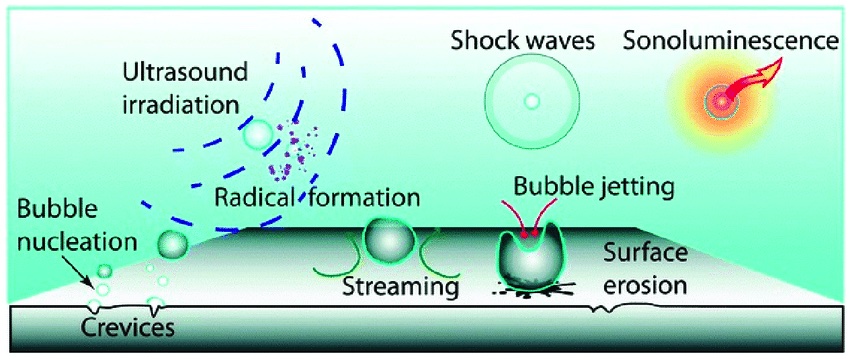
Sonication is the act of applying sound (usually ultrasound) energy to agitate particles in a sample, for various purposes. In the laboratory, it is usually applied using an ultrasonic bath or an ultrasonic probe, colloquially known as a sonicator. In a paper machine, an ultrasonic foil can distribute cellulose fibres more uniformly and strengthen the paper.
Sonication has numerous effects, both chemical and physical. The chemical effects of ultrasound are concerned with understanding the effect of sonic waves on chemical systems. The chemical effects of ultrasound do not come from a direct interaction with molecular species. Studies have shown that no direct coupling of the acoustic field with chemical species on a molecular level can account for sonochemistry or sonoluminescence. Instead, sonochemistry arises from acoustic cavitation: the formation, growth, and implosive collapse of bubbles in a liquid.
Sonication can be used to speed dissolution, by breaking intermolecular interactions. It is especially useful when it is not possible to stir the sample, as with NMR tubes. It may also be used to provide the energy for certain chemical reactions to proceed. Sonication can be used to remove dissolved gases from liquids (degassing) by sonicating the liquid while it is under a vacuum. This is an alternative to the freeze-pump-thaw and sparging methods.
In biological applications, sonication may be sufficient to disrupt or deactivate a biological material. For example, sonication is often used to disrupt cell membranes and release cellular contents. This process is called sonoporation. Sonication is also used to fragment molecules of DNA, in which the DNA subjected to brief periods of sonication is sheared into smaller fragments.
Sonication is commonly used in nanotechnology for evenly dispersing nanoparticles in liquids.
Sonication can also be used to initiate crystallisation processes and even control polymorphic crystallisations. It is used to intervene in anti-solvent precipitations (crystallisation) to aid mixing and isolate small crystals.
Sonication is the mechanism used in ultrasonic cleaning, loosening particles adhering to surfaces. In addition to laboratory science applications, sonicating baths have applications including cleaning objects such as spectacles and jewelry.
Sonication is also used to extract microfossils from rock.
Sonication can also refer to buzz pollination - the process that bees use to shake pollen from flowers by vibrating their wing muscles. Wikipedia, Sonication
Sonication was used to fabricate the three Actuators in the Musical Dynaspheres.
See Also
20.02 - Keely Describing Dynasphere Construction
Actuator
Figure 13.23 - Three Actuators on Shaft and Black and White Coatings
Homogenization
